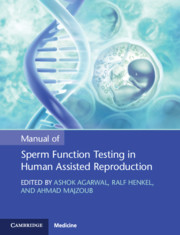Book contents
- Manual of Sperm Function Testing in Human Assisted Reproduction
- Cambridge Laboratory Manuals in Assisted Reproductive Technology
- Manual of Sperm Function Testing in Human Assisted Reproduction
- Copyright page
- Dedication
- Contents
- Contributors
- Short Biography
- Foreword
- Preface
- Introduction
- Chapter 1 Standard Semen Examination: Manual Semen Analysis
- Chapter 2 Standard Semen Analysis: Computer-Assisted Semen Analysis
- Chapter 3 Standard Semen Analysis: Home Sperm Testing
- Chapter 4 Standard Semen Analysis: Leukocytospermia
- Chapter 5 Standard Semen Analysis: Morphology
- Chapter 6 Sperm Vitality: Eosin-Nigrosin Dye Exclusion
- Chapter 7 Sperm Vitality: Hypo-Osmotic Swelling Test
- Chapter 8 Determination of Mitochondrial Membrane Potential by Flow Cytometry in Human Sperm Cells
- Chapter 9 Capacitation and Acrosome Reaction: Fluorescence Techniques to Determine Acrosome Reaction
- Chapter 10 Capacitation and Acrosome Reaction: Histochemical Techniques to Determine Acrosome Reaction
- Chapter 11 Zona Binding: Competitive Sperm-Binding Assay
- Chapter 12 Zona Binding: Hemizona Assay
- Chapter 13 Oolemma Binding: Sperm Penetration Assay
- Chapter 14 Oxidative Stress Testing: Direct Tests
- Chapter 15 Oxidative Stress Testing: Indirect Tests
- Chapter 16 Chromatin Condensation: Aniline Blue Stain
- Chapter 17 Chromatin Condensation: Chromomycin A3 (CMA3) Stain
- Chapter 18 Sperm Chromatin Structure: Toluidine Blue Staining
- Chapter 19 DNA Damage: TdT-Mediated dUTP Nick-End-Labelling Assay
- Chapter 20 DNA Damage: Sperm Chromatin Structure Assay
- Chapter 21 DNA Damage: COMET Assay
- Chapter 22 DNA Damage: Halo Sperm Test
- Chapter 23 DNA Damage: Fluorescent In-Situ Hybridization
- Chapter 24 Clinical Value of Sperm Function Tests
- Chapter 25 Future Developments: Sperm Proteomics
- Conclusion
- Index
- References
Chapter 24 - Clinical Value of Sperm Function Tests
Published online by Cambridge University Press: 05 April 2021
- Manual of Sperm Function Testing in Human Assisted Reproduction
- Cambridge Laboratory Manuals in Assisted Reproductive Technology
- Manual of Sperm Function Testing in Human Assisted Reproduction
- Copyright page
- Dedication
- Contents
- Contributors
- Short Biography
- Foreword
- Preface
- Introduction
- Chapter 1 Standard Semen Examination: Manual Semen Analysis
- Chapter 2 Standard Semen Analysis: Computer-Assisted Semen Analysis
- Chapter 3 Standard Semen Analysis: Home Sperm Testing
- Chapter 4 Standard Semen Analysis: Leukocytospermia
- Chapter 5 Standard Semen Analysis: Morphology
- Chapter 6 Sperm Vitality: Eosin-Nigrosin Dye Exclusion
- Chapter 7 Sperm Vitality: Hypo-Osmotic Swelling Test
- Chapter 8 Determination of Mitochondrial Membrane Potential by Flow Cytometry in Human Sperm Cells
- Chapter 9 Capacitation and Acrosome Reaction: Fluorescence Techniques to Determine Acrosome Reaction
- Chapter 10 Capacitation and Acrosome Reaction: Histochemical Techniques to Determine Acrosome Reaction
- Chapter 11 Zona Binding: Competitive Sperm-Binding Assay
- Chapter 12 Zona Binding: Hemizona Assay
- Chapter 13 Oolemma Binding: Sperm Penetration Assay
- Chapter 14 Oxidative Stress Testing: Direct Tests
- Chapter 15 Oxidative Stress Testing: Indirect Tests
- Chapter 16 Chromatin Condensation: Aniline Blue Stain
- Chapter 17 Chromatin Condensation: Chromomycin A3 (CMA3) Stain
- Chapter 18 Sperm Chromatin Structure: Toluidine Blue Staining
- Chapter 19 DNA Damage: TdT-Mediated dUTP Nick-End-Labelling Assay
- Chapter 20 DNA Damage: Sperm Chromatin Structure Assay
- Chapter 21 DNA Damage: COMET Assay
- Chapter 22 DNA Damage: Halo Sperm Test
- Chapter 23 DNA Damage: Fluorescent In-Situ Hybridization
- Chapter 24 Clinical Value of Sperm Function Tests
- Chapter 25 Future Developments: Sperm Proteomics
- Conclusion
- Index
- References
Summary
Infertility is a major public health concern affecting up to 25 percent of couples worldwide [1]. It is defined by the failure of a couple to achieve conception after one year of regular, unprotected intercourse. The male contributes to roughly 50 percent of the causes of infertility among couples highlighting the importance of research and development in this field of medicine [2]. Conventional semen analysis is the cornerstone test for evaluating the male factor [3]. While the test can provide a general understanding of the male fertility potential, it cannot be used as an accurate predictor of fecundity. About 10 percent of men with normal semen analysis are unable to conceive. On the contrary, an equal percentage of men with abnormal semen analysis have no issues with fertility [4]. Therefore, during the past few decades, the low predictive power of standard semen analysis has triggered researchers to look for more sensitive and specific tests of sperm function. This chapter aims to explore the clinical utility of various tests of sperm function that have been described in literature.
- Type
- Chapter
- Information
- Manual of Sperm Function Testing in Human Assisted Reproduction , pp. 234 - 244Publisher: Cambridge University PressPrint publication year: 2021

